-
Contents
-
Table of Contents
-
Bookmarks
Quick Links
Abbreviation list
Abbreviation/Acronym list
ABBREVIATIONS
2WD
4WD
A/C
ABS
ACC
AI-SHIFT
ALR
CRS
DAC
DISP
ECU
EDR
ELR
EPS
GAWR
GCWR
GVWR
I/M
LATCH
LED
MMT
MTBE
622
MEANING
2 Wheel Drive
4 Wheel Drive
Air Conditioning
Anti-lock Brake System
Accessory
Artificial Intelligence Shift control
Automatic Locking Retractor
Child Restraint System
Downhill Assist Control
Display
Electronic Control Unit
Event Data Recorder
Emergency Locking Retractor
Electric Power Steering
Gross Axle Weight Rating
Gross Combination Weight Rating
Gross Vehicle Weight Rating
Emission Inspection and Maintenance
Lower Anchors and Tethers for Children
Light Emitting Diode
Methylcyclopentadienyl Manganese Tricarbonyl
Methyl Tertiary Butyl Ether
Summary of Contents for Toyota 2012 Highlander
Ознакомьтесь с правилами эксплуатации вашего автомобиля Toyota, изучив электронную версию руководства.
На данной странице представлены следующие типы руководств:
- Общее руководство для владельца
- Руководство по мультимедиа и навигации
- Руководство по вождению в условиях бездорожья
Keys to Quality Maintenance
Toyota Owner manuals and warranty information are the keys to quality maintenance for your vehicle. No need to hunt down a separate Toyota repair manual or Toyota service manual. From warranties on Toyota replacement parts to details on features, Toyota Owners manuals help you find everything you need to know about your vehicle, all in one place.
Detailed Toyota manuals and Toyota warranty information help with questions about your vehicle specifications and maintenance schedules. Plus, learn more about what your Toyota warranty coverage includes. What’s more, Toyota warranty information helps you identify your unique vehicle needs as well as plan future service visits. Select your Toyota model to learn more about the Toyota Warranty for your car, truck or SUV. Or, get the Toyota Manual for your Toyota ride free of charge using our Toyota Owners manual free download option.
Read More
Read Less

602
Abbreviation list
Abbreviation/Acronym list
ABBREVIATIONS MEANING
2WD 2 Wheel Drive
4WD 4 Wheel Drive
A/C Air Conditioning
ABS Anti-lock Brake System
ACC Accessory
ALR Automatic Locking Retractor
CRS Child Restraint System
DAC Downhill Assist Control
DISP Display
ECU Electronic Control Unit
EDR Event Data Recorder
ELR Emergency Locking Retractor
EPS Electric Power Steering
GAWR Gross Axle Weight Rating
GVWR
Gross Vehicle Weight Rating
I/M Emission Inspection and Maintenance
LATCH Lower Anchors and Tethers for Children
LED Light Emitting Diode
MMT
Methylcy clopentadienyl Manganese Tricarbonyl
MTBE
Methyl Tertiary Butyl Ether
OBD On Board Diagnostics
SRS Supplemental Restraint System
TIN Tire Identification Number
TPMS Tire Pressure Warning System
TRAC Traction Control
VIN Vehicle Identification Number
VSC Vehicle Stability Control

TABLE OF CONTENTS
Before driving
When driving
Interior features
Maintenance and care
When trouble arises
Vehicle specifications
For owners
Index
Adjusting and operating features such as door locks, mirrors, and steering column.
Driving, stopping and safe-driving information.
Air conditioning and audio systems, as well as other interior features for a comfortable driving experience.
Cleaning and protecting your vehicle, performing do-it- yourself maintenance, and maintenance information.
What to do if the vehicle needs to be towed, gets a flat tire, or is involved in an accident.
Detailed vehicle information.
Reporting safety defects for U.S. owners, and seat belt and SRS airbag instructions for Canadian owners
Alphabetical listing of information contained in this manual.
1

TABLE OF CONTENTS Index
|
1 |
Before driving |
||
|
1-1. |
Key information |
||
|
Keys ………………………………. |
32 |
||
|
1-2. Opening, closing and |
|||
|
locking the doors |
|||
|
Smart key system…………….. |
35 |
||
|
Wireless remote control ……. |
48 |
||
|
Side doors ………………………. |
54 |
||
|
Back door ……………………….. |
60 |
||
|
Glass hatch …………………….. |
70 |
||
|
1-3. |
Adjustable components |
||
|
(seats, mirrors, |
|||
|
steering wheel) |
|||
|
Front seats ……………………… |
74 |
||
|
Rear seats………………………. |
77 |
||
|
Head restraints………………… |
85 |
||
|
Seat belts ……………………….. |
88 |
||
|
Steering wheel ………………… |
94 |
||
|
Anti-glare inside rear |
|||
|
view mirror…………………….. |
95 |
||
|
Outside rear view mirrors ….. |
98 |
||
|
1-4. Opening and closing the |
|||
|
windows and moon roof |
|||
|
Power windows ……………… |
101 |
||
|
Moon roof ……………………… |
104 |
||
|
1-5. |
Refueling |
||
|
Opening the fuel tank |
|||
|
cap …………………………….. |
109 |
|
1-6. Theft deterrent system |
|||
|
Engine immobilizer |
|||
|
system ………………………… |
113 |
||
|
Alarm ……………………………. |
116 |
||
|
Theft prevention labels |
|||
|
(U.S.A.)……………………….. |
120 |
||
|
1-7. |
Safety information |
||
|
Correct driving posture ……. |
121 |
||
|
SRS airbags ………………….. |
123 |
||
|
Front passenger occupant |
|||
|
classification system……… |
135 |
||
|
Child restraint systems ……. |
142 |
||
|
Installing child restraints ….. |
147 |
||
|
2 |
When driving |
||
|
2-1. |
Driving procedures |
||
|
Driving the vehicle ………….. |
160 |
||
|
Engine (ignition) switch |
|||
|
(vehicles with smart |
|||
|
key system) …………………. |
170 |
||
|
Engine (ignition) switch |
|||
|
(vehicles without smart |
|||
|
key system) …………………. |
174 |
||
|
Automatic transmission …… |
177 |
||
|
Turn signal lever …………….. |
182 |
||
|
Parking brake ………………… |
183 |
||
|
Horn……………………………… |
184 |
||
|
2-2. |
Instrument cluster |
||
|
Gauges and meters ………… |
185 |
||
|
Indicators and warning |
|||
|
lights …………………………… |
187 |
||
|
Multi-information display….. |
191 |
2

|
2-3. Operating the lights and |
|
|
wipers |
|
|
Headlight switch……………… |
200 |
|
Fog light switch ………………. |
206 |
|
Windshield wipers and |
|
|
washer ………………………… |
208 |
|
Rear window wiper and |
|
|
washer ………………………… |
212 |
|
2-4. Using other driving |
|
|
systems |
|
|
Cruise control…………………. |
215 |
|
Rear view monitor |
|
|
system ………………………… |
219 |
|
Driving assist systems …….. |
223 |
|
Hill-start assist control……… |
228 |
|
Downhill assist control |
|
|
system (4WD models) …… |
230 |
|
2-5. Driving information |
|
|
Off-road precautions ……….. |
233 |
|
Cargo and luggage …………. |
238 |
|
Vehicle load limits …………… |
242 |
|
Winter driving tips …………… |
243 |
|
Trailer towing …………………. |
247 |
|
Dinghy towing ………………… |
265 |
3 Interior features
|
3-1. Using the air conditioning |
1 |
||
|
system and defogger |
|||
|
Front manual air |
|||
|
……….conditioning system |
268 |
||
|
Front automatic air |
|||
|
conditioning system………. |
275 |
2 |
|
|
Rear manual air |
|||
|
conditioning system………. |
283 |
||
|
Rear automatic air |
|||
|
conditioning system………. |
286 |
3 |
|
|
Rear window and |
|||
|
outside rear view |
|||
|
……………mirror defoggers |
289 |
||
|
Windshield wiper de-icer |
291 |
||
|
Using the steering wheel |
4 |
||
|
climate remote control |
|||
|
switches ……………………… |
292 |
||
|
3-2. Using the audio system |
|||
|
5 |
|||
|
Audio system |
293 |
||
|
Using the radio ………………. |
297 |
||
|
………..Using the CD player |
304 |
||
|
Playing back MP3 and |
|||
|
WMA discs ………………….. |
312 |
6 |
|
|
Operating an iPod ………….. |
320 |
||
|
Operating a USB |
|||
|
memory ………………………. |
327 |
||
|
Optimal use of the audio |
7 |
||
|
system………………………… |
335 |
||
|
Using the AUX port…………. |
339 |
||
|
Using the steering wheel |
|||
|
………………audio switches |
341 |
||
|
Detachable pole |
|||
|
antenna ………………………. |
344 |
||
3

TABLE OF CONTENTS Index
|
3-3. Using the Bluetooth® audio |
|
|
system |
|
|
Bluetooth® audio system…. |
347 |
|
Using the Bluetooth® |
|
|
audio system……………….. |
350 |
|
Operating a Bluetooth® |
|
|
enabled portable player … |
355 |
|
Setting up a Bluetooth® |
|
|
enabled portable player … |
357 |
|
Bluetooth® audio system |
|
|
setup ………………………….. |
362 |
|
3-4. Using the hands-free |
|
|
phone system |
|
|
(for cellular phone) |
|
|
Hands-free phone system |
|
|
(for cellular phone) |
|
|
features ………………………. |
363 |
|
Using the hands-free |
|
|
phone system………………. |
367 |
|
Making a phone call ……….. |
376 |
|
Setting a cellular phone…… |
380 |
|
Security and system |
|
|
setup ………………………….. |
385 |
|
Using the phone book …….. |
389 |
|
3-5. Using the interior lights |
|
|
Interior lights list …………….. |
396 |
|
• Personal/interior light |
|
|
main switch …………………. |
397 |
|
• Personal/interior lights…… |
397 |
|
• Interior light …………………. |
398 |
|
3-6. Using the storage features |
|
|
List of storage features ……. |
399 |
|
• Glove box ……………………. |
400 |
|
• Console box ………………… |
401 |
|
• Overhead console ………… |
402 |
|
• Cup holders …………………. |
403 |
|
• Bottle holders ………………. |
407 |
|
• Auxiliary boxes …………….. |
408 |
|
• Side table ……………………. |
410 |
|
3-7. Other interior features |
|
|
Sun visors……………………… |
412 |
|
Vanity mirrors ………………… |
413 |
|
Clock…………………………….. |
414 |
|
Conversation mirror ………… |
415 |
|
Power outlets…………………. |
416 |
|
Seat heaters ………………….. |
420 |
|
Armrests ……………………….. |
422 |
|
Floor mat ………………………. |
423 |
|
Luggage compartment |
|
|
features ………………………. |
424 |
|
Garage door opener ……….. |
429 |
|
Compass ………………………. |
435 |
4
|
4 |
Maintenance and care |
||
|
4-1. Maintenance and care |
|||
|
Cleaning and protecting |
|||
|
the vehicle exterior………… |
440 |
||
|
Cleaning and protecting |
|||
|
the vehicle interior…………. |
443 |
||
|
4-2. |
Maintenance |
||
|
Maintenance |
|||
|
requirements………………… |
446 |
||
|
General maintenance………. |
449 |
||
|
Emission inspection and |
|||
|
maintenance (I/M) |
|||
|
programs……………………… |
452 |
||
|
4-3. |
Do-it-yourself maintenance |
||
|
Do-it-yourself service |
|||
|
precautions ………………….. |
453 |
||
|
Hood …………………………….. |
457 |
||
|
Positioning a floor jack …….. |
459 |
||
|
Engine compartment……….. |
463 |
||
|
Tires ……………………………… |
478 |
||
|
Tire inflation pressure ……… |
487 |
||
|
Wheels ………………………….. |
490 |
||
|
Air conditioning filter………… |
493 |
||
|
Wireless remote control/ |
|||
|
electronic key battery…….. |
496 |
||
|
Checking and replacing |
|||
|
fuses …………………………… |
499 |
||
|
Light bulbs……………………… |
510 |
|
5 |
When trouble arises |
||||
|
5-1. |
Essential information |
||||
|
1 |
|||||
|
Emergency flashers |
518 |
||||
|
If your vehicle needs to |
|||||
|
………………………be towed |
519 |
||||
|
If you think something |
|||||
|
is wrong………………………. |
526 |
2 |
|||
|
Fuel pump shut off |
|||||
|
system………………………… |
527 |
||||
|
5-2. Steps to take in an |
|||||
|
3 |
|||||
|
emergency |
|||||
|
If a warning light turns on |
|||||
|
or a warning buzzer |
|||||
|
sounds |
528 |
||||
|
If a warning message is |
4 |
||||
|
displayed …………………….. |
539 |
||||
|
If you have a flat tire ……….. |
540 |
||||
|
If the engine will not start…. |
554 |
||||
|
If the shift lever cannot be |
5 |
||||
|
shifted from P |
556 |
||||
|
If you lose your keys/ |
|||||
|
wireless remote control |
|||||
|
transmitter |
557 |
||||
|
If the electronic key does |
6 |
||||
|
not operate properly ……… |
558 |
||||
|
If the battery is |
|||||
|
discharged…………………… |
560 |
||||
|
If your vehicle overheats …. |
564 |
7 |
|||
5

|
TABLE OF CONTENTS |
Index |
|||
|
If the vehicle becomes |
||||
|
stuck…………………………… |
567 |
|||
|
If your vehicle has to |
||||
|
be stopped in an |
||||
|
emergency ………………….. |
569 |
|||
|
6 |
Vehicle specifications |
|||
|
6-1. |
Specifications |
|||
|
Maintenance data |
||||
|
(fuel, oil level, etc.) ……….. |
572 |
|||
|
Fuel information …………….. |
587 |
|||
|
Tire information ……………… |
590 |
|||
|
6-2. |
Customization |
|||
|
Customizable features ……. |
602 |
|||
|
6-3. |
Initialization |
|||
|
Items to initialize…………….. |
606 |
|||
|
7 |
For owners |
|||
|
Reporting safety defects |
||||
|
for U.S. owners ……………. |
608 |
|||
|
Seat belt instructions |
||||
|
for Canadian owners |
||||
|
(in French)…………………… |
609 |
|||
|
SRS airbag instructions |
||||
|
for Canadian owners |
||||
|
(in French)…………………… |
611 |
|
Index |
|
|
Abbreviation list …………………… |
622 |
|
Alphabetical index ……………….. |
624 |
|
What to do if… …………………….. 633 |
6

7
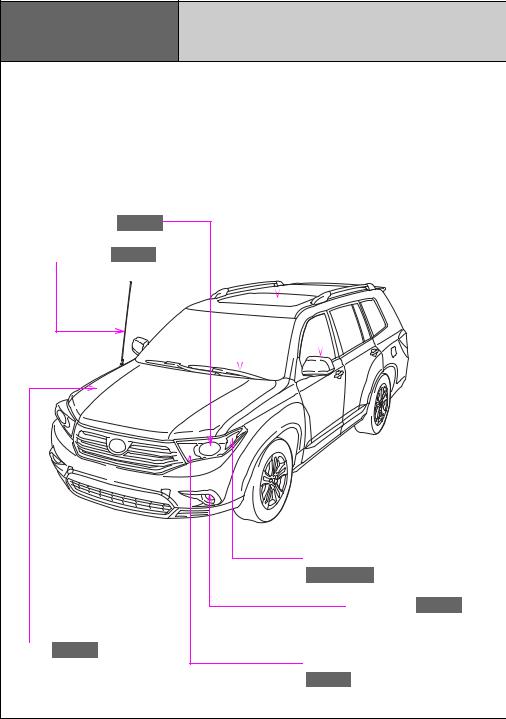
Pictorial index Exterior
Headlights (low beam)
P. 200
Pole antenna P. 344
Hood P. 457
|
Windshield wipers |
P. 208 |
|||||||
|
Moon roof |
||||||||
|
P. 104 |
||||||||
|
Outside rear view |
||||||||
|
mirrors |
||||||||
|
P. 98 |
||||||||
Parking, front side marker and front turn signal lights
P. 182, 200
Fog lights P. 206
Headlights (high beam) and daytime running lights
P. 200
8

|
Rear window defogger |
||||||||||||
|
P. 289 |
||||||||||||
|
Glass hatch |
Back door |
|||||||||||
|
P. 60 |
||||||||||||
|
P. 70 |
||||||||||||
|
Side doors |
||||||||||||
|
P. 54 |
Rear window wiper |
P. 212 |
||||||||||
|
License |
plate lights |
||||||||||||||||||
|
Tires |
P. 200 |
||||||||||||||||||
|
Rear turn signal lights |
|||||||||||||||||||
|
P. 182 |
|||||||||||||||||||
|
Rotation |
|||||||||||||||||||
|
● |
P. 478 |
||||||||||||||||||
|
Replacement |
|||||||||||||||||||
|
P. 540 |
|||||||||||||||||||
|
● |
Stop/tail and rear side |
||||||||||||||||||
|
● |
|||||||||||||||||||
|
P. 584 |
|||||||||||||||||||
|
Inflation pressure |
marker lights |
||||||||||||||||||
|
● |
P. 200 |
||||||||||||||||||
|
P. 590 |
|||||||||||||||||||
|
Information |
|||||||||||||||||||
|
Fuel filler door |
|||||||||||||||||||
|
P. 109 |
: If equipped |
||||||||||||||||||
9
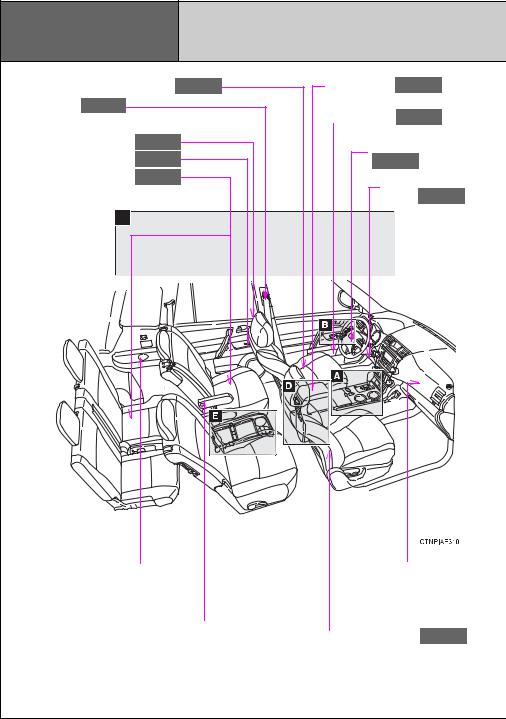
|
Pictorial index |
Interior |
||||
|
Front seats |
P. 74 |
Console box |
P. 401 |
||
|
Seat belts |
P. 88 |
Bottle holders |
P. 407 |
||
|
Head restraints |
P. 85 |
SRS driver airbag |
|||
|
Power window switches |
P. 101 |
P. 123 |
|||
|
Rear seats |
P. 77 |
SRS driver knee |
|||
|
airbag P. 123 |
|||||
|
C |
|
Cup holders |
SRS front passenger |
|||||
|
P. 403 |
||||||
|
Armrests |
airbag |
P. 123 |
||||
|
P. 422 |
||||||
SRS side airbags P. 123
10
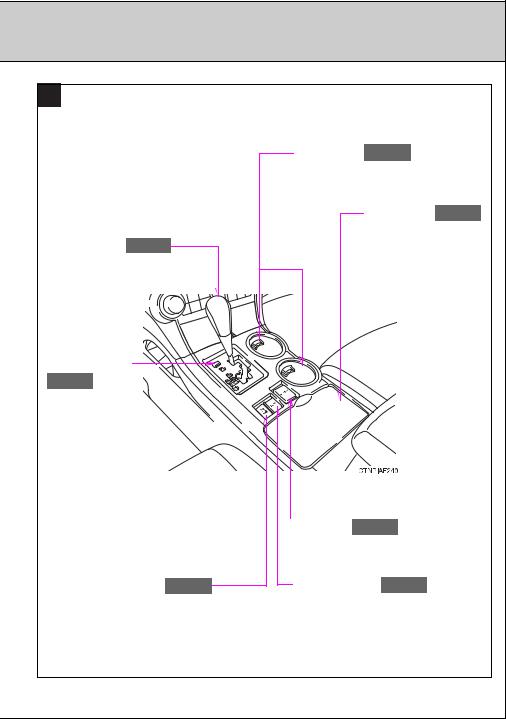
|
A |
||||
|
Cup holders P. 403 |
||||
|
Cup holders |
P. 403 |
|||
|
Shift lever |
P. 177 |
|||
|
Shift lock |
||||
|
override button |
||||
|
P. 556 |
||||
|
Power outlet P. 416 |
||||
|
“DAC” switch*1 |
P. 230 |
“SNOW” switch P. 178 |
||
|
*1: 4WD models |
||||
|
11 |
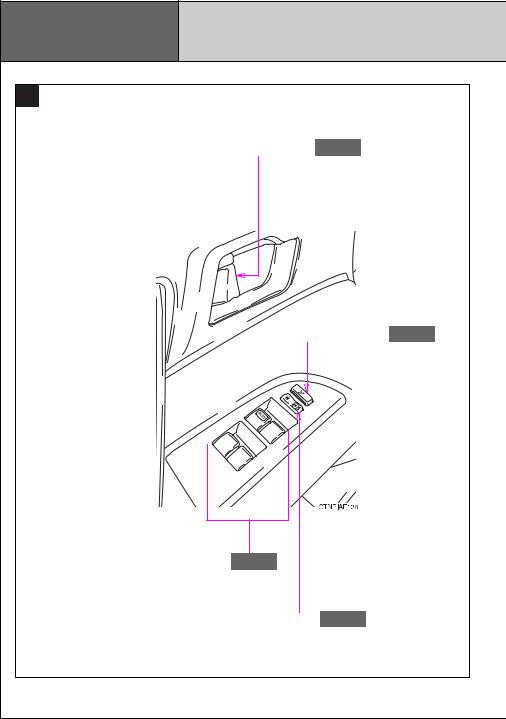
|
Pictorial index |
Interior |
||
|
B |
|||
|
Inside door lock button |
P. 55 |
||
|
Window lock switch |
P. 101 |
||
|
Power window switches P. 101 |
|||
|
Door lock switch |
P. 55 |
||
|
12 |
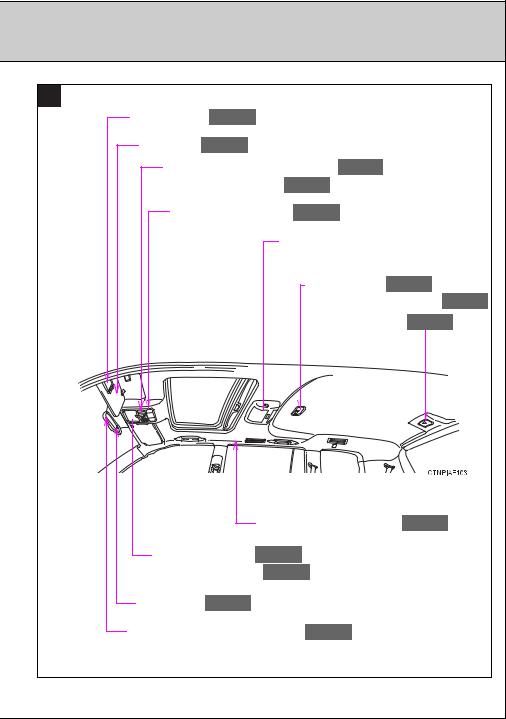
|
C |
||||||||
|
Vanity mirrors |
P. 413 |
|||||||
|
Sun visors |
P. 412 |
|||||||
|
Garage door opener switches |
P. 429 |
|||||||
|
Moon roof switches |
P. 104 |
|||||||
|
Personal/interior lights |
P. 397 |
|||||||
|
Rear seat entertainment system , *2 |
||||||||
|
Interior light |
P. 398 |
|||||||
|
Personal/interior lights |
P. 397 |
|||||||
|
Interior light |
P. 398 |
|||||||
|
SRS curtain shield airbags |
P. 123 |
|||||||
|
Overhead console |
P. 402 |
|||||||
|
Conversation mirror |
P. 415 |
|||||||
|
Compass |
P. 435 |
|||||||
|
Anti-glare inside rear view mirror |
P. 95 |
|||||||
|
: If equipped |
||||||||
|
*2: Refer to “Navigation System Owner’s Manual”. |
||||||||
|
13 |
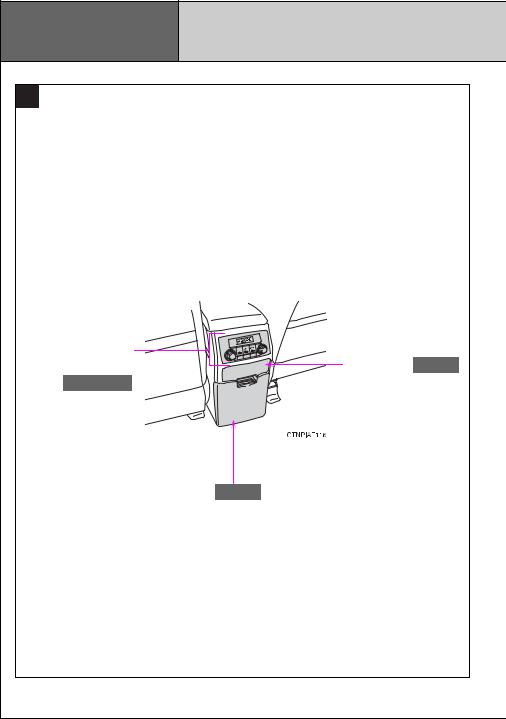
|
Pictorial index |
Interior |
||
|
D |
|||
|
Rear air |
|||
|
conditioning |
|||
|
system |
Cup holders |
P. 403 |
|
|
P. 283, 286 |
|||
|
Console box |
P. 401 |
||
|
14 |
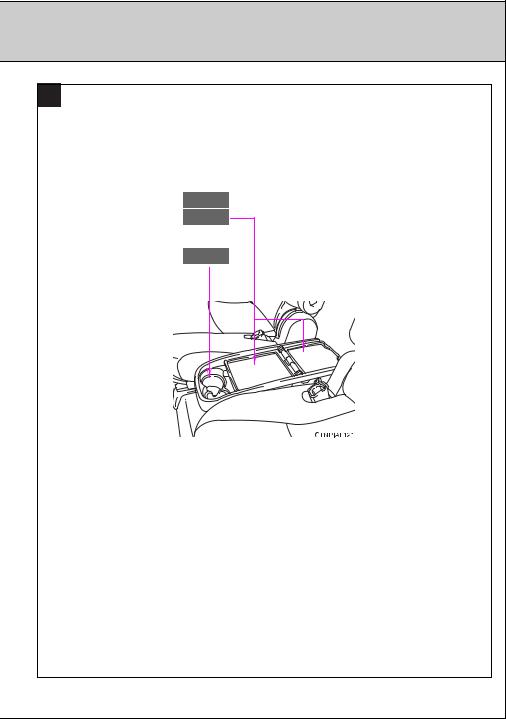
|
E |
|
|
Auxiliary box |
P. 408 |
|
Side table |
P. 410 |
|
Cup holders |
P. 403 |
|
: If equipped |
|
|
15 |
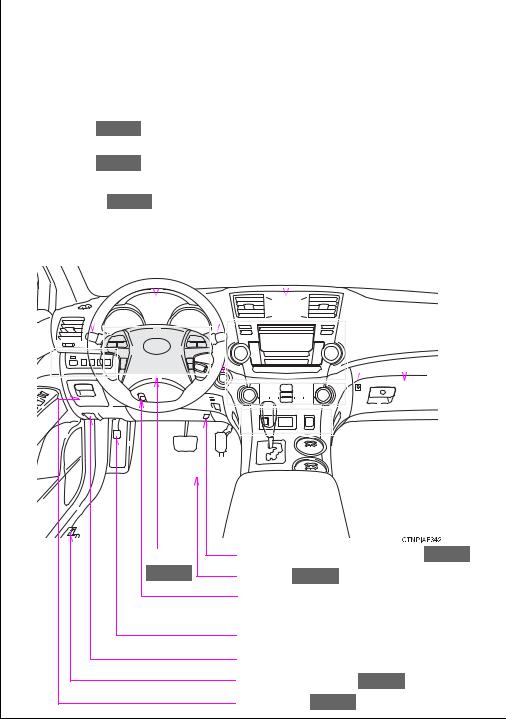
P. 94
|
Pictorial index |
Instrument panel |
||||||||||||||||||||||||||||||||||||
|
Engine (ignition) switch |
|||||||||||||||||||||||||||||||||||||
|
(vehicles with smart key system) |
P. 170 |
||||||||||||||||||||||||||||||||||||
|
Rear view monitor system |
|||||||||||||||||||||||||||||||||||||
|
Windshield wiper and |
P. 219 |
||||||||||||||||||||||||||||||||||||
|
Multi-information display |
|||||||||||||||||||||||||||||||||||||
|
washer switch |
P. 208 |
P. 191 |
|||||||||||||||||||||||||||||||||||
|
Clock |
|||||||||||||||||||||||||||||||||||||
|
Rear window wiper and |
P. 414 |
||||||||||||||||||||||||||||||||||||
|
washer switch |
P. 212 |
Power back door |
|||||||||||||||||||||||||||||||||||
|
Fog light switch |
|||||||||||||||||||||||||||||||||||||
|
main switch |
|||||||||||||||||||||||||||||||||||||
|
P. 206 |
|||||||||||||||||||||||||||||||||||||
|
Headlight switch |
P. 200 |
||||||||||||||||||||||||||||||||||||
|
P. 62 |
|||||||||||||||||||||||||||||||||||||
|
Turn signal lever |
P. 182 |
Glove box |
|||||||||||||||||||||||||||||||||||
|
Gauges and |
P. 400 |
||||||||||||||||||||||||||||||||||||
|
meters |
|||||||||||||||||||||||||||||||||||||
|
P. 185 |
|||||||||||||||||||||||||||||||||||||
Tire pressure warning reset switch P. 480 Floor mat P. 423
Tilt and telescopic steering lock release lever
|
Parking brake pedal |
P. 183 |
|
|
Hood release lever |
||
|
P. 457 |
Fuel filler door opener P. 109
Auxiliary box P. 408
16
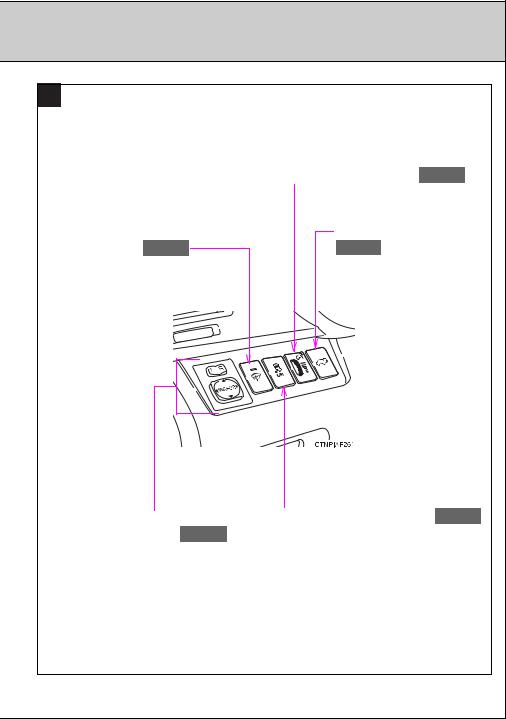
|
A |
|||||
|
Instrument panel light control dial |
P. 186 |
||||
|
Windshield wiper de-icer |
Power back door switch |
||||
|
switch |
P. 291 |
P. 60 |
|||
|
Outside rear view |
Enhanced VSC/TRAC off switch |
P. 224 |
|||
|
mirror switches |
P. 98 |
||||
|
: If equipped |
|||||
|
17 |
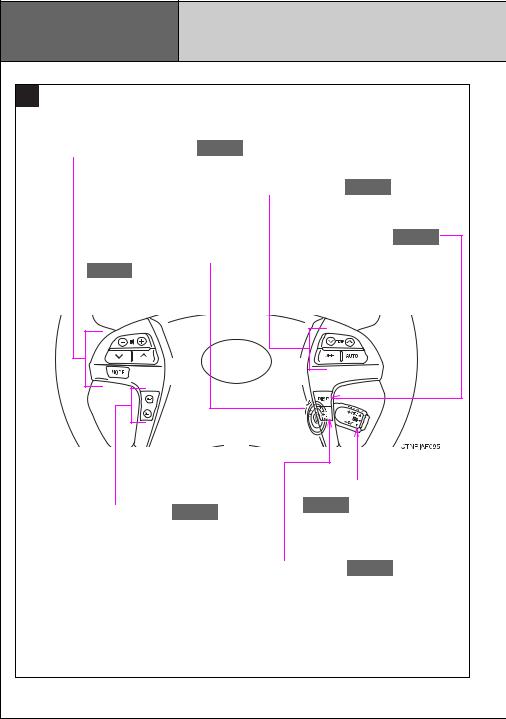
|
Pictorial index |
Instrument panel |
|||
|
B |
||||
|
Audio remote control switches P. 341 |
||||
|
Climate remote control switches |
P. 292 |
|||
|
Engine (ignition) switch (vehicles |
“DISP” switch |
P. 192 |
||
|
without smart key system) |
||||
|
P. 174 |
||||
|
Cruise control switch |
||||
|
Telephone switch , *2 |
P. 368 |
P. 215 |
||
|
Talk switch , *2 |
P. 368 |
|||
|
18 |
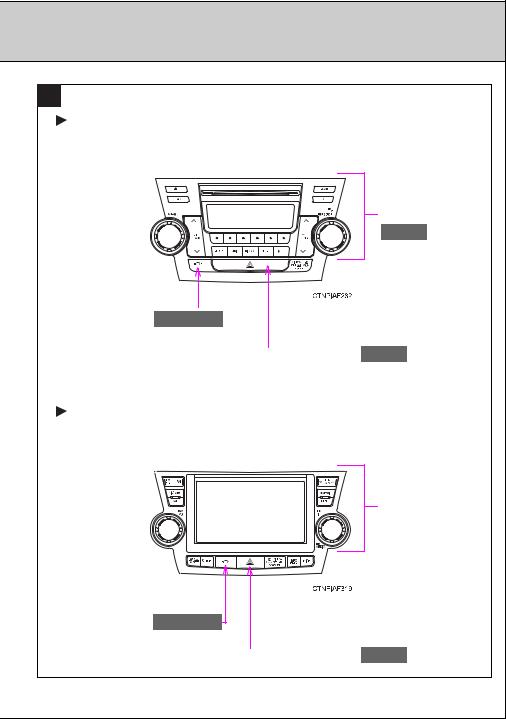
|
C |
||
|
Vehicles without navigation system |
||
|
Audio system |
||
|
P. 293 |
||
|
Security indicator P. 113, 116 |
||
|
Emergency flasher switch |
P. 518 |
|
|
Vehicles with navigation system |
||
|
Rear view |
||
|
monitor/navigation |
||
|
system*2 |
||
|
Security indicator |
P. 113, 116 |
|
|
Emergency flasher switch |
P. 518 |
|
|
: If equipped |
||
|
*2: Refer to “Navigation System Owner’s Manual”. |
||
|
19 |
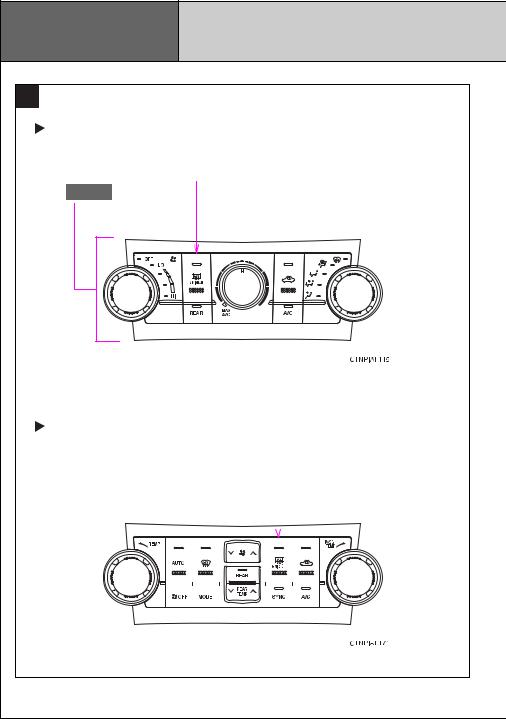
P. 289
Pictorial index Instrument panel
D
Vehicles with a front manual air conditioning system
Rear window and outside rear view mirror defogger Air conditioning switch /rear window defogger switch 
Vehicles with a front automatic air conditioning system
|
Air conditioning |
Rear window and outside rear view mirror defogger |
||||||||||||||
|
switch /rear window defogger switch |
|||||||||||||||
|
system |
P. 289 |
||||||||||||||
|
P. 275 |
|||||||||||||||
20
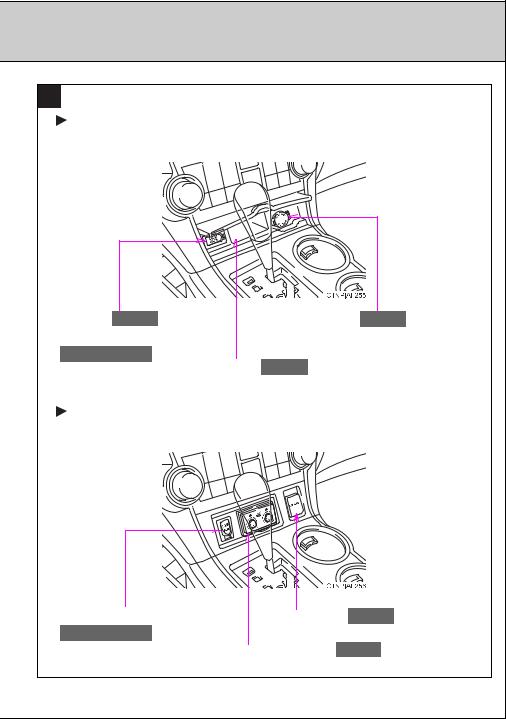
|
E |
||||||
|
Vehicles without seat heater |
||||||
|
AUX port |
P. 339 |
Power outlet |
P. 416 |
|||
|
AUX port/USB port |
||||||
|
P. 320, 327, 339 |
Auxiliary box |
P. 408 |
||||
|
Vehicles with seat heater |
||||||
|
AUX port/USB port |
Power outlet |
P. 416 |
||||
|
P. 320, 327, 339 |
||||||
|
Seat heater knobs |
P. 420 |
|||||
|
: If equipped |
||||||
|
21 |
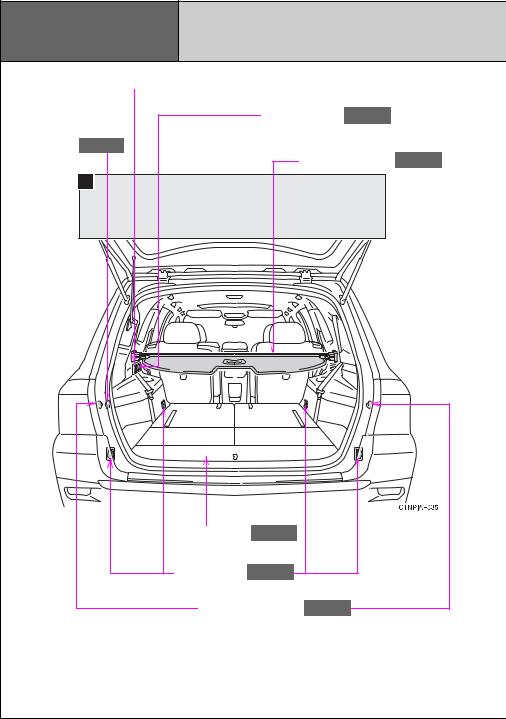
|
Pictorial index |
Luggage compartment |
|||
|
A/V input port , *2 |
||||
|
Power outlet |
Power outlet |
P. 416 |
||
|
P. 416 |
Luggage cover |
P. 425 |
||
|
A |
||||
|
Auxiliary box |
P. 424 |
|||
|
Cargo hooks |
P. 424 |
|||
|
Grocery bag hooks P. 424 |
||||
|
22 |
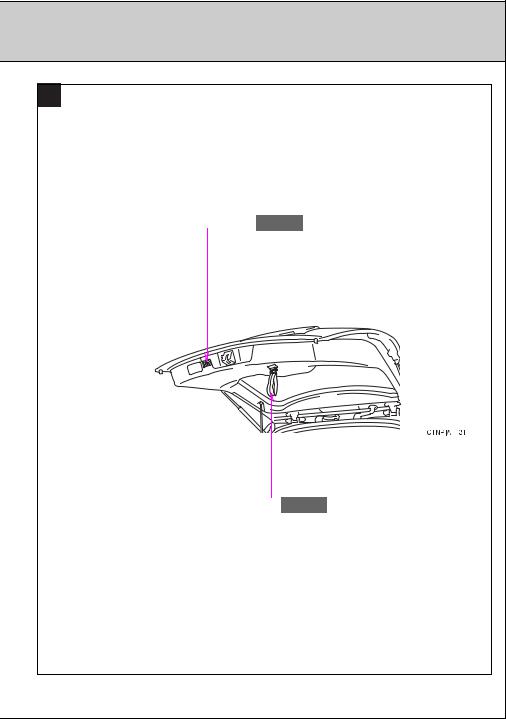
|
A |
||
|
Power back door switch |
P. 61 |
|
|
Back door strap |
P. 60 |
|
|
: If equipped |
||
|
*2: Refer to “Navigation System Owner’s Manual”. |
||
|
23 |

For your information

Please note that this manual covers all models and all equipment, including options. Therefore, you may find some explanations for equipment not installed on your vehicle.
All specifications provided in this manual are current at the time of printing. However, because of the Toyota policy of continual product improvement, we reserve the right to make changes at any time without notice.
Depending on specifications, the vehicle shown in the illustrations may differ from your vehicle in terms of equipment.

Approximately five hours after the engine is turned off, you may hear sound coming from under the vehicle for several minutes. This is the sound of a fuel evaporation leakage check and, it does not indicate a malfunction.

A wide variety of non-genuine spare parts and accessories for Toyota vehicles are currently available on the market. You should know that these parts are not covered by Toyota warranty and that Toyota is not responsible for their performance, repair, or replacement, or for any damage they may cause to, or adverse effect they may have on, your Toyota vehicle.
This vehicle should not be modified with non-genuine Toyota products. Modification with non-genuine Toyota products may affect performance, safety or durability, and may even violate governmental regulations. In addition, damage or performance problems resulting from the modification may not be covered under warranty.
24


The installation of a mobile two-way radio system in your vehicle could affect electronic systems such as:
●Multiport fuel injection system/sequential multiport fuel injection system ●Cruise control system
●Anti-lock brake system ●SRS airbag system
●Seat belt pretensioner system
Be sure to check with your Toyota dealer for precautionary measures or special instructions regarding installation of a mobile two-way radio system.

The SRS airbag and seat belt pretensioner devices in your Toyota contain explosive chemicals. If the vehicle is scrapped with the airbags and seat belt pretensioners left as they are, this may cause an accident such as fire. Be sure to have the systems of the SRS airbag and seat belt pretensioner removed and disposed of by a qualified service shop or by your Toyota dealer before you scrap your vehicle.

Special handling may apply, See www.dtsc.ca.gov/hazardouswaste/perchlorate.
Your vehicle has components that may contain perchlorate. These components may include airbag, seat belt pretensioners, and wireless remote control batteries.
25


Your Toyota is equipped with sophisticated computers that record certain information about your vehicle’s operation, such as:
•Engine speed
•Accelerator status
•Brake status
•Vehicle speed
•Shift position
The data recorded varies according to the grade level and options the vehicle is equipped with. The computers do not record conversations, sound or pictures.
● Data usage
Toyota may use the data recorded in these computers to diagnose malfunctions, conduct research and development, and improve quality.
Toyota will not disclose the recorded data to a third party except:
•With the consent of the vehicle owner or with the consent of the lessee if the vehicle is leased
•In response to an official request by the police, a court of law or a government agency
•For research purposes where the data is not tied to a specific vehicle or vehicle owner
26
● Event data recorder
Your vehicle has computers that monitor and control certain aspects of your vehicle. These computers assist in driving and maintaining optimal vehicle performance.
Besides storing data useful for troubleshooting, there is an event data recorder (EDR) that records data in a crash or near crash event.
The SRS airbag sensor assembly contains the EDR. In a crash or near crash event, this device may record the following information:
•Engine speed
•Whether the brake pedal was depressed or not
•Vehicle speed
•To what extent the accelerator pedal was depressed
•The transmission shift position
•Whether the driver and front passenger wore seat belts or not
•Driver’s seat position
•SRS airbag deployment data
•SRS airbag system diagnostic data
•Front passenger’s occupant classification
The information above is intended to be used for the purpose of improving vehicle safety performance. Unlike general data recorders, the EDR does not record sound data such as conversation between passengers.
● Disclosure of the EDR data
Toyota will not disclose the data recorded in an EDR to a third party except when:
•An agreement from the vehicle’s owner (or the leasing company for a leased vehicle) is obtained
•Officially requested to by the police or other authorities
•Necessary, for use as a defense for Toyota in a lawsuit
•Ordered to by a court of law
However, if necessary, Toyota will:
•Use the data for research on Toyota vehicle safety performance
•Disclose the data to a third party for research purposes without disclosing details of the vehicle owner, and that only when deemed necessary
•Disclose summarized data cleared of vehicle identification information to a non-Toyota organization for research purposes
27


■General precautions while driving
Driving under the influence: Never drive your vehicle when under the influence of alcohol or drugs that have impaired your ability to operate your vehicle. Alcohol and certain drugs delay reaction time, impair judgment and reduce coordination, which could lead to an accident that could result in death or serious injury.
Defensive driving: Always drive defensively. Anticipate mistakes that other drivers or pedestrians might make and be ready to avoid accidents.
Driver distraction: Always give your full attention to driving. Anything that distracts the driver, such as adjusting controls, talking on a cellular phone or reading can result in a collision with resulting death or serious injury to you, your occupants or others.
■General precaution regarding children’s safety
Never leave children unattended in the vehicle, and never allow children to have or use the key.
Children may be able to start the vehicle or shift the vehicle into neutral. There is also a danger that children may injure themselves by playing with the windows, the moon roof, or other features of the vehicle. In addition, heat build-up or extremely cold temperatures inside the vehicle can be fatal to children.
28

Symbols used throughout this manual


This is a warning against anything which may cause death or injury to people if the warning is ignored. You are informed about what you must or must not do in order to reduce the risk of injury to yourself and others.

This is a warning against anything which may cause damage to the vehicle or its equipment if the warning is ignored. You are informed about what you must or must not do in order to avoid or reduce the risk of damage to your Toyota and its equipment.

Safety symbol
The symbol of a circle with a slash through it means “Do not”, “Do not do this”, or “Do not let this happen”.
Arrows indicating operations


29
30

|
1-1. |
Key information |
|
|
Keys …………………………….. |
32 |
|
|
1-2. Opening, closing and |
||
|
locking the doors |
||
|
Smart key system ………….. |
35 |
|
|
Wireless remote control ….. |
48 |
|
|
Side doors…………………….. |
54 |
|
|
Back door……………………… |
60 |
|
|
Glass hatch …………………… |
70 |
|
|
1-3. |
Adjustable components |
|
|
(seats, mirrors, |
||
|
steering wheel) |
||
|
Front seats ……………………. |
74 |
|
|
Rear seats…………………….. |
77 |
|
|
Head restraints………………. |
85 |
|
|
Seat belts ……………………… |
88 |
|
|
Steering wheel ………………. |
94 |
|
|
Anti-glare inside rear |
||
|
view mirror ………………….. |
95 |
|
|
Outside rear view |
||
|
mirrors………………………… |
98 |
1-4. Opening and closing the
|
windows and moon roof |
||
|
Power windows ……………. |
101 |
|
|
Moon roof……………………. |
104 |
|
|
1-5. |
Refueling |
|
|
Opening the fuel tank |
||
|
cap …………………………… |
109 |
|
|
1-6. Theft deterrent system |
||
|
Engine immobilizer |
||
|
system ……………………… |
113 |
|
|
Alarm………………………….. |
116 |
|
|
Theft prevention labels |
||
|
(U.S.A.) …………………….. |
120 |
|
|
1-7. |
Safety information |
|
|
Correct driving posture….. |
121 |
|
|
SRS airbags………………… |
123 |
|
|
Front passenger occupant |
||
|
classification system …… |
135 |
|
|
Child restraint systems….. |
142 |
|
|
Installing child |
||
|
restraints …………………… |
147 |
31

1-1. Key information
Keys
The following keys are provided with the vehicle.










• Operating the smart key
system ( P. 35)
• Operating the wireless
remote control function ( P. 48)


32

1-1. Key information

Take out the mechanical key.
After using the mechanical key, store it in the electronic key. Carry the mechanical key together with the electronic key. If the electronic key battery is depleted, you will need the mechanical key.
( P. 558)
■When required to leave a key to the vehicle with a parking attendant
Lock the glove box as circumstances demand. ( P. 400)
Vehicles without smart key system: Carry the master key for your own use and provide the attendant with the valet key.
Vehicles with smart key system: Remove the mechanical key for your own use and provide the attendant with the electronic key only.
■Key number plate
Keep the plate in a safe place such as your wallet, not in the vehicle. In the event that a key is lost, a new key can be made by your Toyota dealer using the key number plate. ( P. 557)
■When riding in an aircraft (vehicles with smart key system)
When bringing an electronic key onto an aircraft, make sure you do not press any buttons on the electronic key while inside the aircraft cabin. If you are carrying an electronic key in your bag etc., ensure that the buttons are not likely to be pressed accidentally. Pressing a button may cause the electronic key to emit radio waves that could interfere with the operation of the aircraft.
1 Beforedriving
33

1-1. Key information

■To prevent key damage
●Do not subject the keys to strong shocks, expose them to high temperatures by placing them in direct sunlight, or get them wet.
●Do not expose the keys to electromagnetic materials or attach any material that blocks electromagnetic waves to the key surface.
●Do not disassemble the key.
34

1-2. Opening, closing and locking the doors
Smart key system
The following operations can be performed simply by carrying the electronic key on your person, for example in your pocket.
(The driver should always carry the electronic key.)
|
Electronic key |
1 |
|
Electronic key |
|
|
driving Before |
|
|
Electronic key |
|
|
Electronic key |




: If equipped
35

1-2. Opening, closing and locking the doors



Grip the handle to unlock the doors.
Make sure to touch the sensor on the back of the handle.
The door cannot be unlocked for 3 seconds after the door is locked.
Press the lock button to lock the doors.
Press the button to unlock the door.
The door cannot be unlocked for 3 seconds after the door is locked.
If you carry the electronic key on your person, the back door can be opened even if it is locked. Lock the back door again when you leave the vehicle. The back door will not lock automatically after it has been opened and then closed.
36

1-2. Opening, closing and locking the doors
Press the button to lock the door.

Press and hold the button to open the glass hatch. The glass hatch will pop up.
The glass hatch can be unlocked only when the back door is closed.
1 Beforedriving
37

1-2. Opening, closing and locking the doors

■ Antenna location



38

1-2. Opening, closing and locking the doors
■Effective range (areas within which the electronic key is detected)
When locking or unlocking the doors
This system can be operated when the electronic key is within about 2.3 ft. (0.7 m) of either of the outside front door handles.
When starting the engine or changing “ENGINE START STOP” switch modes
This system can be operated when the electronic key is inside the vehicle.
When opening the glass hatch and locking or unlocking the doors
This system can be operated when the electronic key is within about 2.3 ft. (0.7 m) of the back door handle.
1 Beforedriving
39

1-2. Opening, closing and locking the doors
■Operation signals
A buzzer sounds and the emergency flashers flash to indicate that the doors have been locked/unlocked. (Locked: Once; Unlocked: Twice)
■Conditions affecting operation
The smart key system uses weak radio waves. In the following situations, the communication between the electronic key and the vehicle may be affected, preventing the smart key system and wireless remote control from operating properly. (Ways of coping: P. 558)
●When the electronic key battery is depleted
●Near a TV tower, electric power plant, gas station, radio station, large display, airport or other facility that generates strong radio waves or electrical noise
●When carrying a portable radio, cellular phone, cordless phone or other wireless communication devices
●When the electronic key is in contact with, or is covered by a metallic object
●When multiple electronic keys are in the vicinity
●When carrying or using the electronic key together with the following devices that emit radio waves
•Another vehicle’s electronic key
•A wireless key that emits radio waves
•Personal computer
●If window tint with a metallic content or metallic objects are attached to the rear window
■Switching the door unlock function
It is possible to set which doors the entry function unlocks. STEP 1 Turn the “ENGINE START STOP” switch OFF.
STEP 2 When the indicator on the key surface is turned off, push and hold




40

1-2. Opening, closing and locking the doors
The setting changes each time an operation is performed, as shown below. (When changing the setting continuously, release the buttons, wait for at least 5 seconds, and repeat step 2.)
|
Multi-information |
Unlocking doors |
Beep |
|
|
display |
|||
|
Hold the driver’s door han- |
|||
|
dle to unlock only the |
Exterior: Beeps three |
||
|
driver’s door. |
|||
|
times |
|||
|
Hold the front passenger’s |
|||
|
Interior: Pings once |
|||
|
door handle to unlock all |
|||
|
doors. |
|||
|
Hold either front door han- |
Exterior: Beeps twice |
||
|
dle to unlock all doors. |
Interior: Pings once |
||
To prevent unintended triggering of the alarm, unlock the doors using the wireless remote control and open and close a door once after the settings have been changed. (If a door is not opened within 60 seconds after is pressed, the doors will be locked again and the alarm will automatically be set.)
In case that the alarm is triggered, immediately stop the alarm. ( P. 116)
■Battery-saving function
In the following circumstances, the entry function is disabled in order to prevent the vehicle and electronic key batteries from discharging.
●When the entry function has not been used for 2 weeks or more
●When the electronic key has been left within approximately 3 ft. (1 m) of the vehicle for 10 minutes or more
The system will resume operation when…
●The vehicle is locked using the door handle lock button.
●The vehicle is locked/unlocked using the wireless remote control function. ( P. 48)
●The vehicle is locked/unlocked using the mechanical key. ( P. 558)
1 Beforedriving
41

1-2. Opening, closing and locking the doors
■Electronic key battery depletion
●The standard battery life is 1 to 2 years. (The battery becomes depleted even if the electronic key is not used.) If the smart key system or the wireless remote control function does not operate, or the detection area becomes smaller, the battery may be depleted. Replace the battery when necessary. ( P. 497)
●If the battery becomes low, an alarm will sound in the cabin when the engine stops. ( P. 43)
●To avoid serious deterioration, do not leave the electronic key within 3 ft. (1 m) of the following electrical appliances that produce a magnetic field.
•TVs
•Personal computers
•Recharging cellular phones or cordless phones
•Table lamps
■To operate the system properly
Make sure to carry the electronic key when operating the system. Do not get the electronic key too close to the vehicle when operating the system from the outside of the vehicle.
Depending on the position and holding condition of the electronic key, the key may not be detected correctly and the system may not operate properly. (The alarm may go off accidentally, or the door lock prevention may not function.)
■Note for the entry function
●Even when the electronic key is within the effective range (detection areas), the system may not operate properly in the following cases.
•The electronic key is too close to the window or outside door handle, near the ground, or in a high place when the doors are locked or unlocked.
•The electronic key is on the instrument panel, luggage cover, floor or in the glove box when the engine is started or “ENGINE START STOP” switch modes are changed.
●Do not leave the electronic key on top of the instrument panel or near the door pockets when exiting the vehicle. Depending on the radio wave reception conditions, it may be detected by the antenna outside the cabin and the door will become lockable from the outside, possibly trapping the electronic key inside the vehicle.
42

1-2. Opening, closing and locking the doors
●As long as the electronic key is within the effective range, the doors may be locked or unlocked by anyone.
●Even if the electronic key is not inside the vehicle, it may be possible to start the engine if the electronic key is near the window.
●The doors may unlock if a large amount of water splashes on the door handle, such as in the rain or in a car wash. (The doors will automatically be locked after approximately 60 seconds if the doors are not opened and closed.)
●Gripping the door handle when wearing a glove may not unlock the door.
●If the wireless remote control is used to lock the doors when the electronic key is near the vehicle, there is a possibility that the door may not be unlocked by the entry function. (Use the wireless remote control to unlock the doors.)
■When the vehicle is not driven for extended periods
To prevent theft of the vehicle, do not leave the electronic key within 6 ft. (2 m) of the vehicle.
■Security feature
If a door is not opened within approximately 60 seconds after the vehicle is unlocked, the security feature automatically locks the vehicle again.
■Alarms and warning indicators
A combination of exterior and interior alarms as well as warning lights and warning messages shown on the multi-information display are used to reduce the chance of vehicle theft and accidents resulting from erroneous operation.
●When any warning lights come on:
Take appropriate measures according to which warning light comes on. ( P. 528)
●When a warning message is shown on the multi-information display: Take appropriate measures according to the warning message on the multi-information display. ( P. 539)
1 Beforedriving
43

1-2. Opening, closing and locking the doors
●When an alarm sounds:
Take appropriate measures according to the following table.
|
Alarm |
Situation |
Correction procedure |
|
|
Tried to lock the doors |
Retrieve the elec- |
||
|
using the entry function |
tronic key from the |
||
|
while the electronic key |
passenger compart- |
||
|
Exterior alarm |
was still inside the passen- |
ment and lock the |
|
|
sounds once for |
ger compartment. |
doors again. |
|
|
2 seconds |
|||
|
Tried to close the glass |
Retrieve the elec- |
||
|
hatch with the electronic |
|||
|
tronic key and close |
|||
|
key inside and all doors |
|||
|
the glass hatch. |
|||
|
locked. |
|||
|
Tried to exit the vehicle |
Turn the “ENGINE |
||
|
Exterior alarm |
with the electronic key and |
||
|
START STOP” switch |
|||
|
sounds once for |
lock the doors without first |
||
|
OFF and lock the |
|||
|
60 seconds |
turning the “ENGINE |
||
|
doors again. |
|||
|
START STOP” switch OFF. |
|||
|
Exterior alarm |
Tried to lock the vehicle |
Close all of the doors |
|
|
sounds once for |
using the entry function |
and lock the doors |
|
|
10 seconds |
while a door was open. |
again. |
|
|
Interior alarm |
Tried to open the door and |
Shift the shift lever to |
|
|
sounds continu- |
exit the vehicle without |
||
|
P. |
|||
|
ously |
shifting the shift lever to P. |
||
|
Switched to ACCESSORY |
|||
|
mode while the driver’s |
Turn the “ENGINE |
||
|
door was open. (Opened |
|||
|
START STOP” switch |
|||
|
the driver’s door when the |
|||
|
OFF and close the |
|||
|
“ENGINE START STOP” |
|||
|
Interior alarm |
driver’s door. |
||
|
switch was in ACCES- |
|||
|
beeps repeatedly |
|||
|
SORY mode.) |
|||
|
Turned the “ENGINE |
|||
|
START STOP” switch OFF |
Close the driver’s |
||
|
while the driver’s door was |
door. |
||
|
open. |
|||
44

1-2. Opening, closing and locking the doors
|
Alarm |
Situation |
Correction procedure |
|
|
Tried to close the driver’s |
|||
|
door after carrying the key |
Shift the shift lever to |
||
|
Interior and exte- |
outside the vehicle with the |
||
|
P, turn the “ENGINE |
|||
|
“ENGINE START STOP” |
|||
|
rior alarms sound |
START STOP” switch |
||
|
switch in IGNITION ON or |
|||
|
continuously.* |
OFF and close the |
||
|
ACCESSORY mode and |
|||
|
driver’s door again. |
|||
|
without the shift lever |
|||
|
being in P. |
|||
|
The electronic key has a |
Replace the electronic |
||
|
low battery. |
key battery. |
||
|
Interior alarm |
Tried to start the engine |
||
|
without the electronic key |
Start the engine with |
||
|
beeps once.* |
|||
|
being present, or when the |
the electronic key |
||
|
electronic key was not |
present. |
||
|
functioning normally. |
|||
|
Tried to close the driver’s |
Turn the “ENGINE |
||
|
door after carrying the key |
|||
|
START STOP” switch |
|||
|
outside the vehicle without |
|||
|
OFF and close the |
|||
|
turning the “ENGINE |
|||
|
driver’s door again. |
|||
|
Interior alarm |
START STOP” switch OFF. |
||
|
beeps once and |
|||
|
An occupant carried the |
|||
|
exterior alarm |
electronic key outside the |
||
|
sounds 3 times.* |
vehicle and closed the |
Bring the electronic |
|
|
door when the “ENGINE |
key back into the vehi- |
||
|
START STOP” switch was |
cle. |
||
|
in IGNITION ON or |
|||
|
ACCESSORY mode. |
|||
*: A message will be shown on the multi-information display.
■If the smart key system does not operate properly
●Locking and unlocking the doors: Use the mechanical key. ( P. 558)
●Starting the engine. ( P. 558)
■When the electronic key battery is fully depleted
P. 497
1 Beforedriving
45

1-2. Opening, closing and locking the doors
■Customization that can be configured at Toyota dealer
It is possible to deactivate the smart key system etc. (Customizable features P. 602)
■Certification for the smart key system

FCC ID: NI4TMLF-3 HYQ14AAB HYQ13BZS HYQ14ABK HYQ13CZA
NOTE:
This device complies with part 15 of the FCC Rules. Operation is subject to the following two conditions: (1) This device may not cause harmful interference, and (2) this device must accept any interference received, including interference that may cause undesired operation.
FCC WARNING:
Changes or modifications not expressly approved by the party responsible for compliance could void the user’s authority to operate the equipment.

NOTE:
Operation is subject to the following two conditions: (1) this device may not cause interference, and (2) this device must accept any interference, including interference that may cause undesired operation of the device.
46

1-2. Opening, closing and locking the doors

■Caution regarding interference with electronic devices
●People with implanted pacemakers or cardiac defibrillators should keep away from the smart key system antennas. ( P. 38) The radio waves may affect the operation of such devices. If necessary, the entry function can be disabled. Ask your Toyota dealer for details, such as the frequency of radio waves and timing of emitting the radio waves. Then, consult your doctor to see if you should disable the entry function.
●Users of any electrical medical device other than implanted pacemakers and implanted cardiac defibrillators should consult the manufacturer of the device for information about its operation under the influence of radio waves.
Radio waves could have unexpected effects on the operation of such medical devices.
Ask your Toyota dealer for details for disabling the entry function.
1 Beforedriving
47

1-2. Opening, closing and locking the doors
Wireless remote control
The wireless remote control can be used to lock and unlock the vehicle from outside the vehicle.



Pressing the button unlocks the driver’s door. Pressing the button again within 3 seconds unlocks the other doors.


The glass hatch can be opened only when the back door is closed.

48

1-2. Opening, closing and locking the doors



Pressing the button unlocks the driver’s door. Pressing the button again within 3 seconds
unlocks the other doors.

Sounds alarm

The glass hatch can be opened only when the back door is closed.



Pressing the button unlocks the driver’s door. Pressing the button again within 3 seconds unlocks the other doors.


1 Beforedriving
49

1-2. Opening, closing and locking the doors
■Operation signals
Doors: A buzzer sounds and the emergency flashers flash to indicate that the doors have been locked/unlocked. (Locked: Once; Unlocked: Twice)
Back door: A buzzer sounds and the emergency flashers flash twice to indicate that the back door has been opened/closed.
■Panic mode

When 
about one second, an alarm will sound for
about 60 seconds and the vehicle lights
will flash to deter any person from trying
to break into or damage your vehicle.
To stop the alarm, push any button on the


When is pushed for longer than about one second, an alarm will sound for about 60 seconds and the vehicle lights will flash to deter any person from trying to break into or damage your vehicle.
To stop the alarm, push any button on the wireless remote control.
■Door lock buzzer
If a door is not fully closed, a buzzer sounds continuously if an attempt to lock the door is made. Fully close the door to stop the buzzer, and lock the vehicle once more.
50









